Namibia April 19-20, 2018
Kaokoland
We were driving North with our guide, Charles, from the Hoanib River area to the Kaokoland area (now also called Kunene for the Kunene River). This area is most famous for the Himba and Herero tribes, which we would be visiting. Compared to the rest of the country, this area is less developed as the dry climate and the vast mountains make it difficult to cultivate. And as we drove, we marveled yet again at how different the terrain was. And how beautiful.
We passed lots of springboks and oryx as we drove on the sandy, corrugated road.
We passed an Augur buzzard which to me looked like hawk, but to Charles it looked like a penguin. Charles – you need to go to Antarctica or at least read my South Georgia post to see penguins!
We passed more fairy circles (please see the post on Namibia, chapter 1 for the full background on the fairy circles). They are circular patches of land barren of plants. 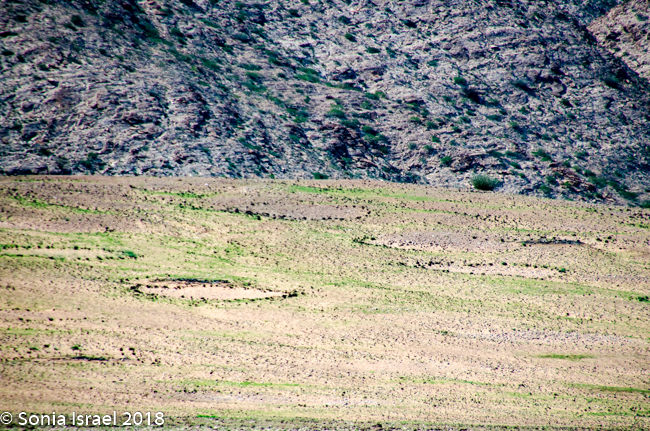 And no one knows for sure what they are. There are lots of theories of course, but my personal favorite is the oral myths of the Himba who believe that these barren patches are
And no one knows for sure what they are. There are lots of theories of course, but my personal favorite is the oral myths of the Himba who believe that these barren patches are 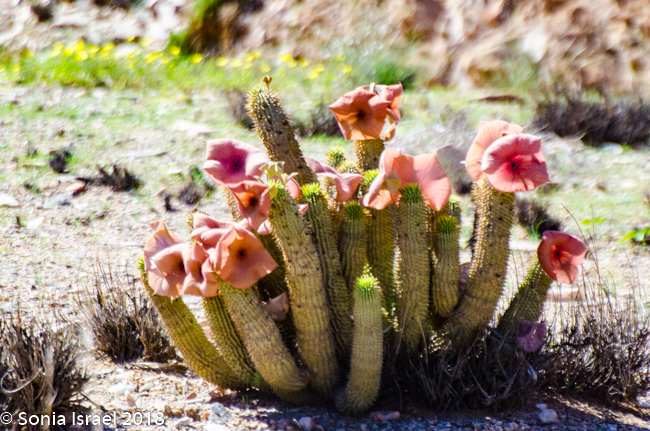 the footprints of the gods.
the footprints of the gods.
We passed a blooming Hoodia plant, also known as the Bushman’s hat. This is a leafless, spiny succulent plant that is believed to have medicinal properties, especially as an appetite suppressant. The flowers smell like rotten meat which might explain this belief. Luckily, we just drove past it and didn’t stop to smell it.
We passed a whole family of ostriches. There was a male ostrich (father?), a female ostrich (mother?0 and 5 babies, toddling along next to them. I had never seen baby ostriches before. So cute! But don’t get too close…
We passed some giraffes crossing the road. One was pregnant, and Charles said she looked like she would deliver any minute. I wished it was right then. It would have been amazing to watch a giraffe being born. Charles, the consummate teacher, reminded us that all mammals have seven vertebrae, including the giraffe. When the giraffes are standing tall, they are called towers. A group of giraffes however, is called a journey.
The area was one large plain full of fields of grasses in different shades of green. As in all of Namibia, the terrain kept changing, but, unlike the Skeleton Coast (see Namibia Chapter 3), it was always green.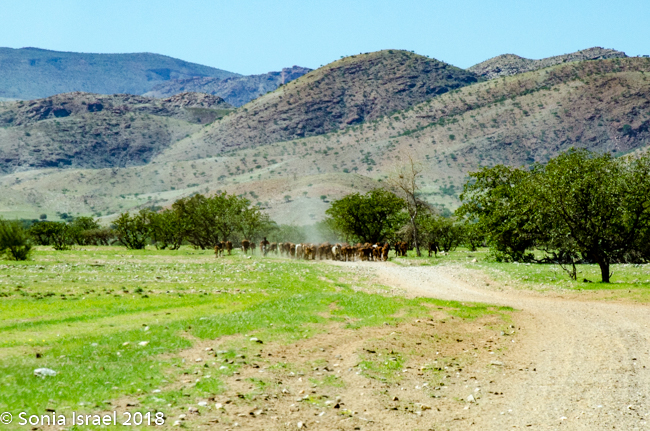
At one point we had to slow down as the road was full of cattle. Remember, around here, cows are money. This was one rich person as there were lots of cows. More likely, it was cattle from several people within a Herero tribe.
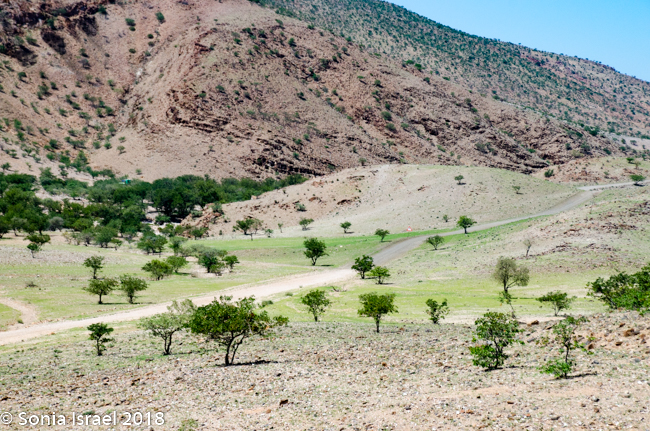 We passed what looked like orchards, and flat trees called the Shepherd Tree as the flatness of the tree branches creates shade for the shepherd.
We passed what looked like orchards, and flat trees called the Shepherd Tree as the flatness of the tree branches creates shade for the shepherd.
We stopped for lunch along the side of the road, overlooking the orchards and watching a shepherd with his goats on one side and a large canyon with purple mountains on the other side. Lunch was fish cakes and other goodies that Gerhard had made for us that morning over the campfire (see Namibia Chapter 5 to learn about Gerhard and our amazing camping experience).
Sesfontein
Our destination was the Khowarib Lodge just outside of Sesfontein, a small town, or more like a settlement in this area, with a population of about 7000. The name comes from the six “fountains”, or springs, in this area. We drove by the local post office, liquor store and general store which were full of people. It felt strange to see groups of people and small shops after all that time in near isolation. Almost like a culture shock, or back to civilization. Sesfontein is a dusty spot, more like an outpost than a town. But for the locals it is their place to hang out, to see neighbors and to spend their money. We would be back here tomorrow when we would get to observe and meet the locals up close and personal (Namibia Chapter 7).
We kept driving, past a trickle of the Wanib River. We would be told later that the Wanib is “to us all” as it goes through so many villages. The Wanib is the boundary 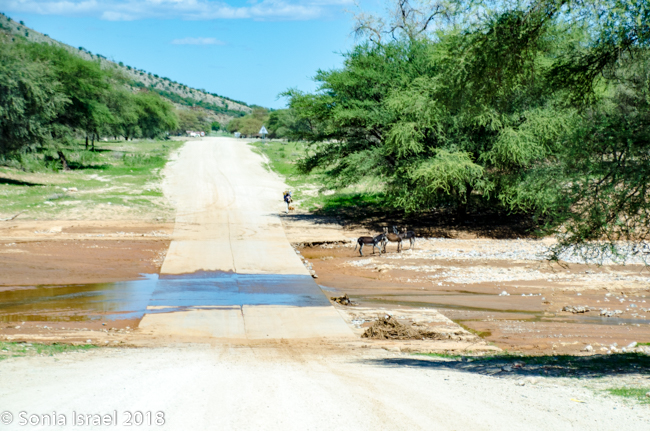 between the Damara tribes and the Herero tribes. I was sorry not to be able to visit any Damara villages, especially since Charles is Damara. That will have to wait for next time.
between the Damara tribes and the Herero tribes. I was sorry not to be able to visit any Damara villages, especially since Charles is Damara. That will have to wait for next time.
Khowarib Lodge
We finally arrived at the Khowarib Lodge on the banks of the Hoanib river in the magnificent Khowarib Gorge. Or we thought we had arrived. We found ourselves at a campground, which the lodge also owned. So we backtracked and tried again, this time finding the right road that ended in the gravel parking lot of the lodge. We walked up the path to the main house and were greeted with lunch, which we had already eaten….oh well. The main reception area and dining area is built as a lapa, an immense thatched structure constructed from local materials in a traditional style. We sat there in the evenings as well, having drinks and looking out over the kopje, (a South African word for a hill in a generally flat area), except to me it looked more like a mountain than a hill.
We checked in and were shown to our room. The whole complex is made up of 14 canvas rooms on stilts. Our deck overlooked the mountains and we did have a little time to sit there and just relax. The bathroom was all outdoors. It was a full bath, mind you, but there were trees growing in the middle of it and while there was a high stone wall surrounding it, it was open to the sky. At first I thought, “how lovely.” Until I had to spend time out there in the hot sun, or in the evening when all the bugs appeared.
- Outdoor shower
- View from our porch
But that first afternoon, as soon as we dropped off our luggage, we donned swimsuits, and walked over to the swimming pool. Swimming pool? No, it was more like a soaking pool as you could reach one end from the other in two strokes. But it was so hot out that it felt great to just stand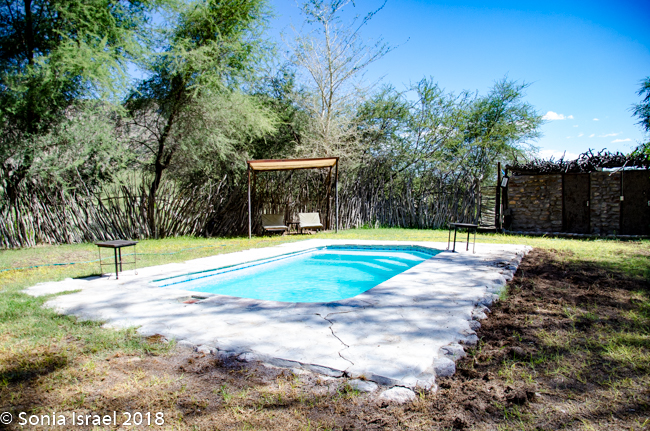 in the water and cool off. A French family joined us and we laughed (quietly) when the women put on swimming goggles. It was funny as there was really no swimming in this pool.
in the water and cool off. A French family joined us and we laughed (quietly) when the women put on swimming goggles. It was funny as there was really no swimming in this pool.
Dinner that evening was a set meal, and one that we could not eat. The lodge had been told about our dietary restrictions, but somehow, they did not get the message. So we ate mashed potatoes. Not much of a dinner.
But when we got back to our room, we sat on our deck and were awed by the stars. Just as it had been a few nights before when we were camping near the Hoanib 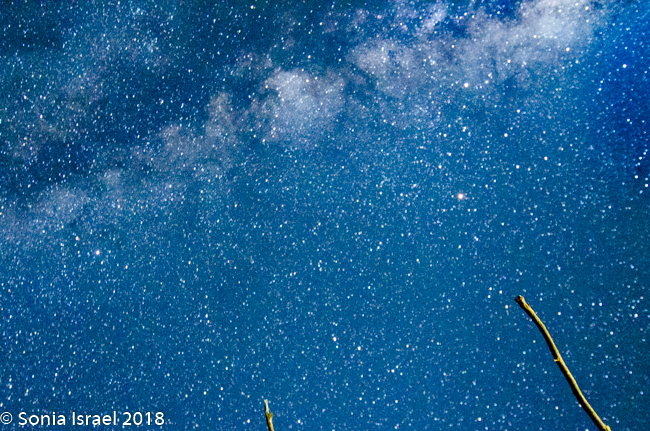 River, the sky was again covered with thousands of little glimmering diamonds.
River, the sky was again covered with thousands of little glimmering diamonds.
April 20, 2018
 Breakfast at the Khowarib Lodge was not quite as fancy as at the other lodges we stayed at. But it was sufficient. Cereal. Yogurts. Fruit. It was buffet style and the best part was listening to all the birds chirping and singing for us.
Breakfast at the Khowarib Lodge was not quite as fancy as at the other lodges we stayed at. But it was sufficient. Cereal. Yogurts. Fruit. It was buffet style and the best part was listening to all the birds chirping and singing for us.
There is not much to see in this video, but close your eyes and just listen.
Herero and Himba – nope, not in this post…
That morning we drove off to visit a Herero village and a Himba village. That was amazing and earned its own blog, Namibia Chapter 7.
Searching for Rock Carvings
That afternoon, we continued touring with our Herero guide, Ueera, this time to visit the rock carvings found in this area. Most tourists visit Twyfelfontein (“jumping waterhole”) as it is a large site of ancient rock engravings in this area. But it is crowded. People camp there. Ueera said he had a better place to go see rock engravings. So we piled into his car and off we went.
We drove off the road, onto a field of waist-high green grass. The grass was swaying in the breeze, creating waves of color.
Kori Bustard
Suddenly Ueera veered off the path and headed quickly towards the mountain. There was kori bustard walking in the tall grass, which he had noticed.
The kori bustard is the largest bird that is still capable of flying. Because it is so heavy, and like most bustards, it is mostly a ground-dwelling bird. It is not a particularly colorful bird, being mostly grey and brown, with some black and white colored plumage. Even the crest on its head is black. But their feathers have a pink tinge to them. But the most impressive part is their size. They can stand up to 3 feet tall and weight up to 40 pounds. And that is why they spend 70% of their time on the ground.
We watched for a bit as the bird walked around, mostly away from us. And then we realized there were actually two of them. What a coup to see them.
A Dazzle of Hartmann Zebras
The grass we were driving through was green with white tips. As it swayed in the 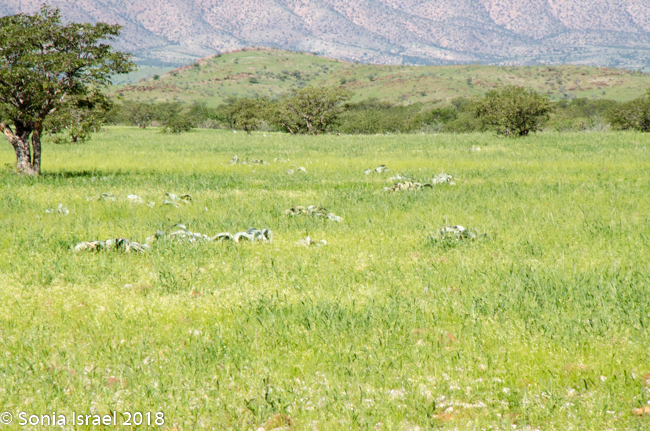 breeze, it looked like it was undulating. There were Welsitschia everywhere, all blooming (see Namibia Chapter 4), whole fields of them.
breeze, it looked like it was undulating. There were Welsitschia everywhere, all blooming (see Namibia Chapter 4), whole fields of them.
And then we suddenly saw a zeal (or dazzle) of zebras (that is what you call a group of zebras). With babies. They were running as fast as they could. Not from us, but just because it was fun. These were Hartmann Mountain Zebras, with white bellies. Hartmann zebras live in small groups of 7-12, are agile climbers and are able to live in arid conditions and steep mountainous country – exactly the kind of terrain we were in.
The Rock Carvings
We drove and drove and eventually stopped in what looked like the middle of nowhere. We climbed out of the car and hiked over rocks in a dry riverbed, slowly making our way up hill. We were standing in a narrow path between two mountains, with sheer rock faces. And at the end of this dead end valley was a pool of water reflecting the mountains right back at us.
And then Ueera started pointing out the carvings and telling us the stories. Unlike the cave paintings of other tribes in South Africa, stone carving was the medium used by the San (Bushmen) artists in Damaraland. When the Damara herders arrived in this area in the 1930s, the San left, leaving behind their ancestors carvings from thousands of years ago.
There were engravings of giraffe, rhinos, people, skins, oryx and any other animal you could see in this area. Some were quite high on the rocks. It is estimated that these carvings are 2000-2500 years old and were made by the San (once called the Bushmen) who used to live in this valley.
At one point, Ueera climbed up the rocks, as agile as an antelope, to be sure we could see the carvings. And then, just as gracefully, he ran back down.
Back for dinner with our new friends
When we got back to the lodge, we relaxed on the deck and chatted with two new friends, a couple from Hamburg, Thomas and Andrea. One of the best perks of traveling is meeting other people, from all over the world, who also like to explore the world. In fact, we seemed to be the only Americans at this lodge; most of the others were German or French. Thomas and Andrea joined Charles, Andy and me for dinner on our last night in Namibia.
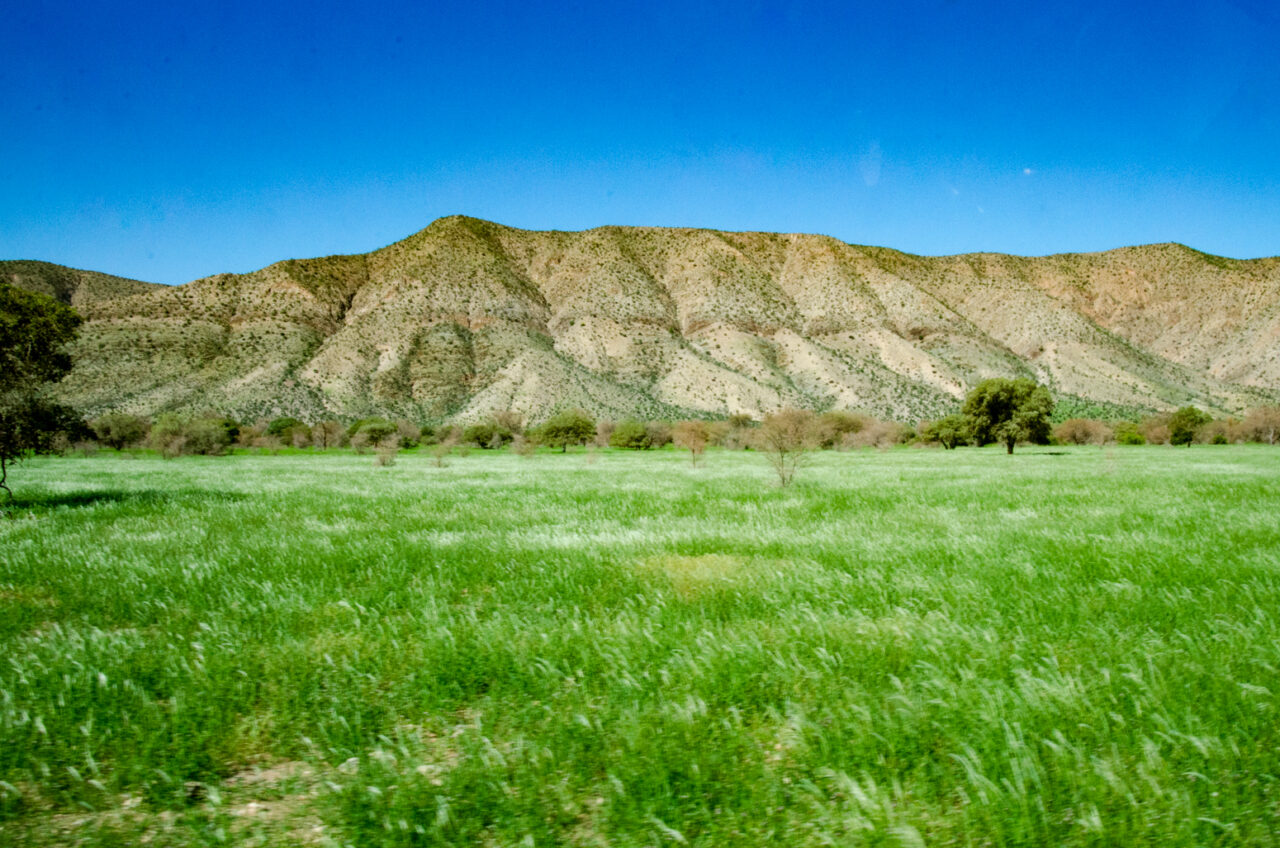
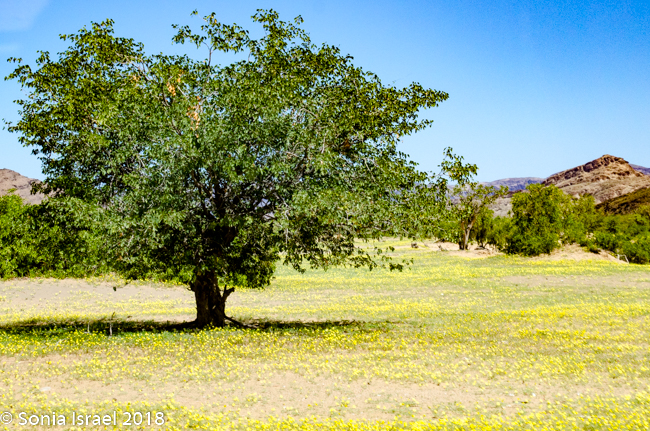
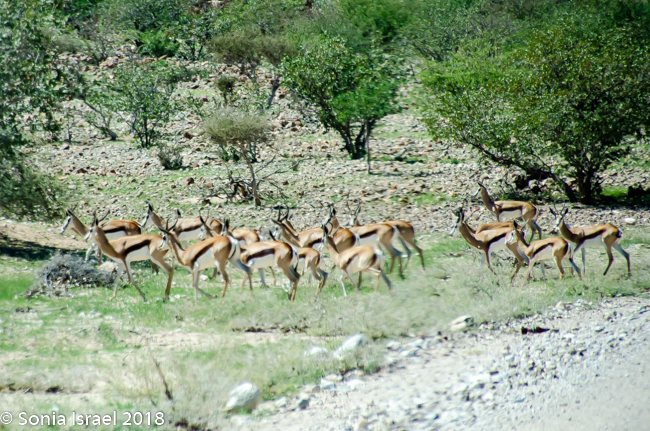
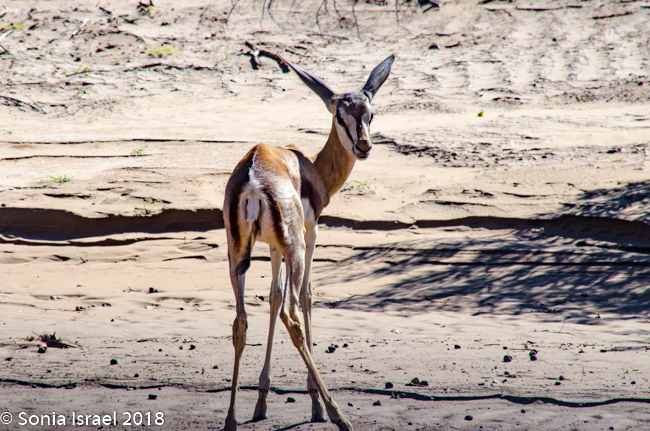
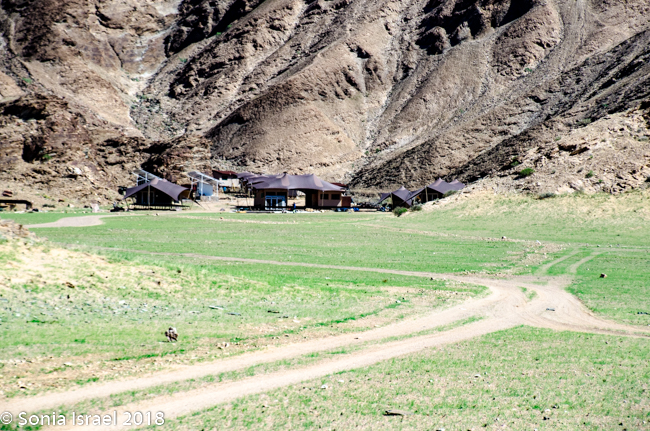

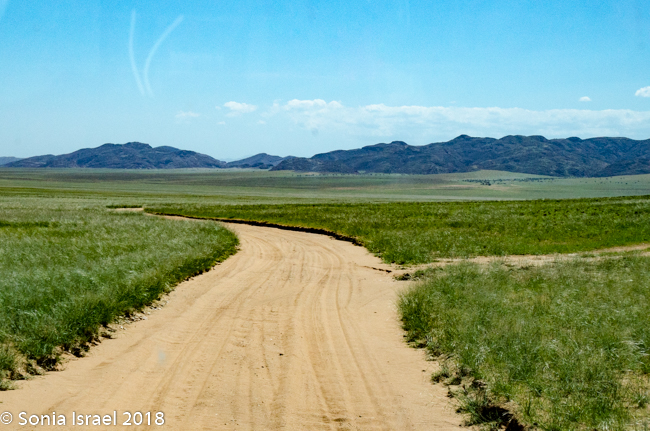

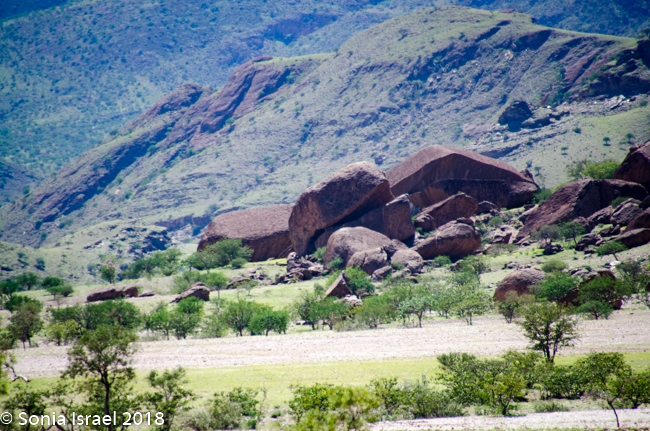
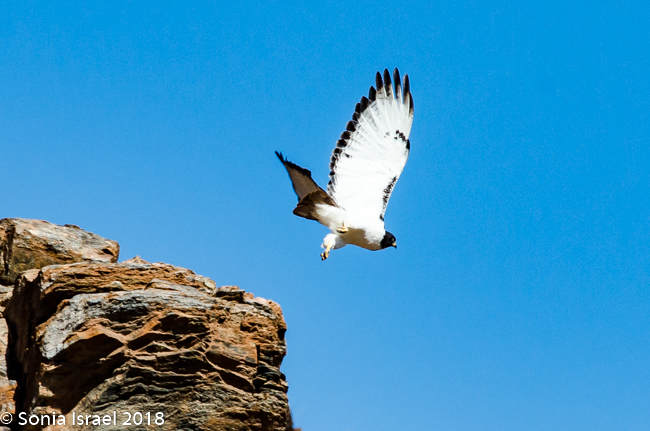
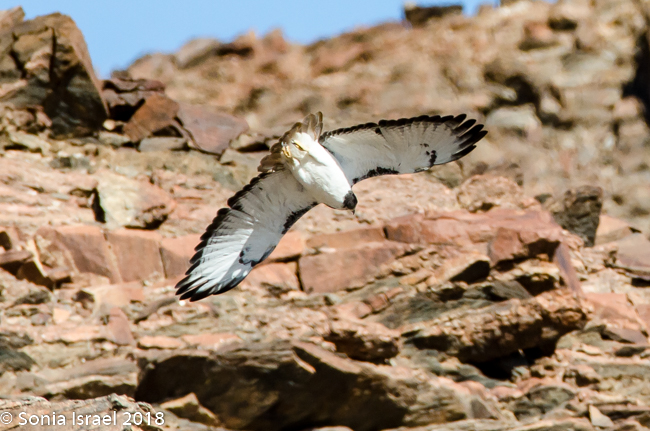
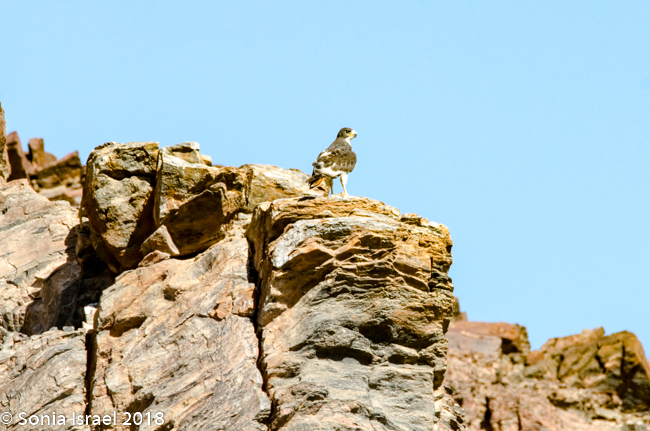
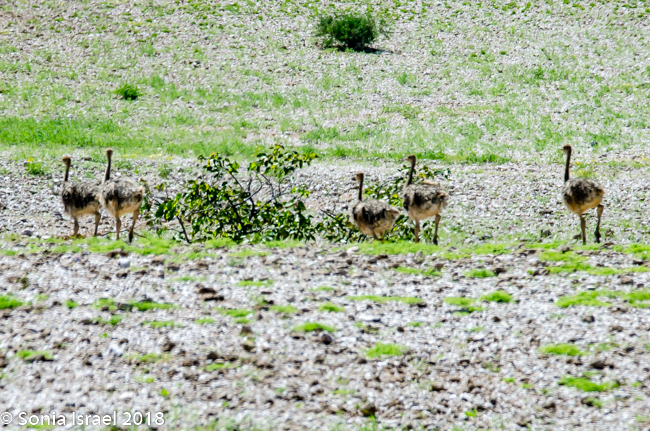
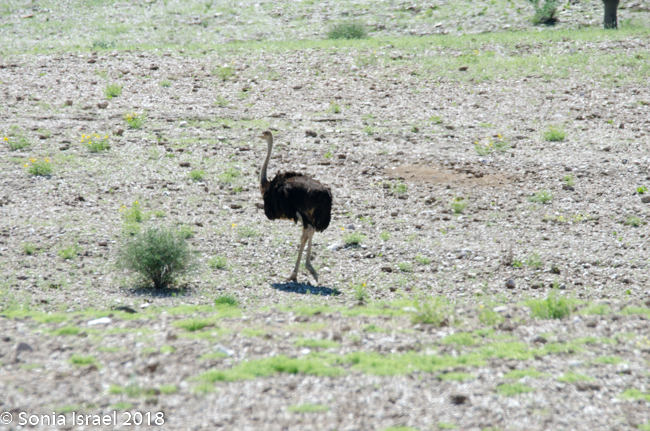
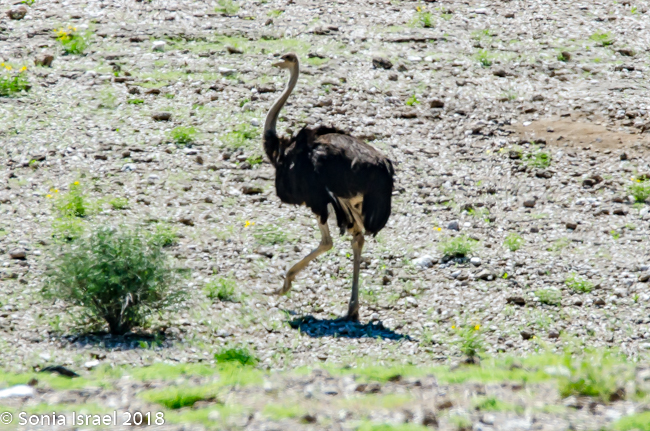
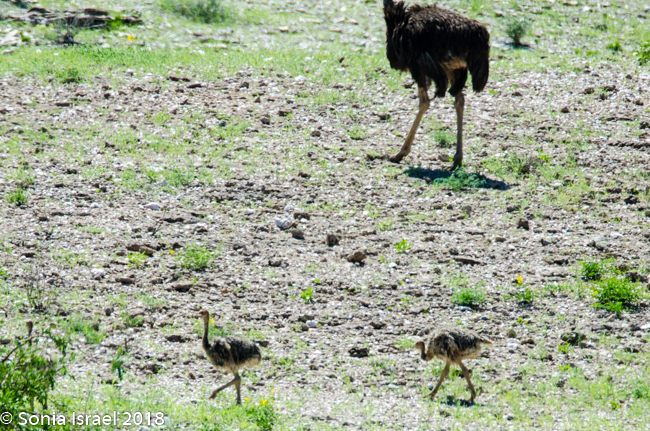

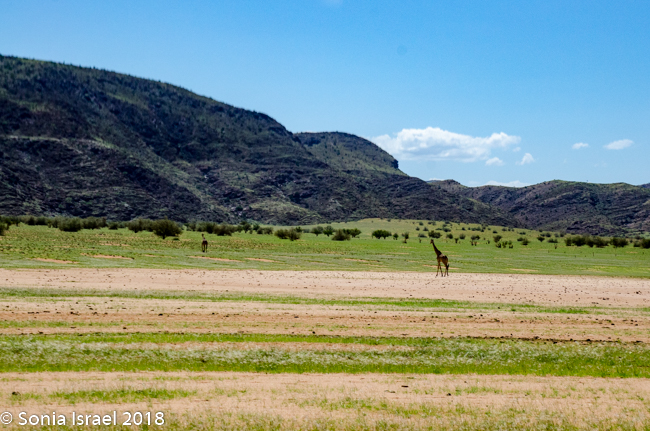
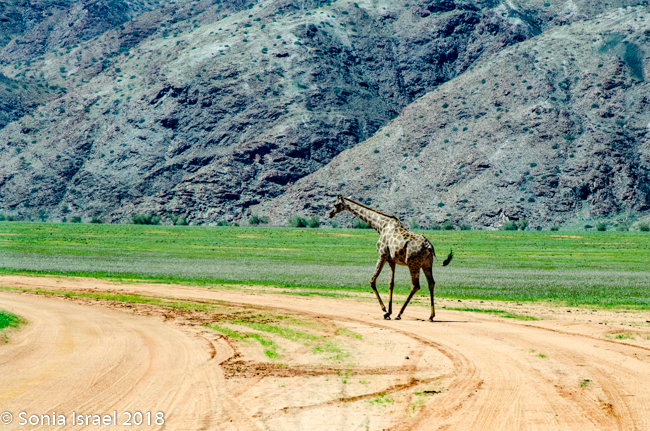
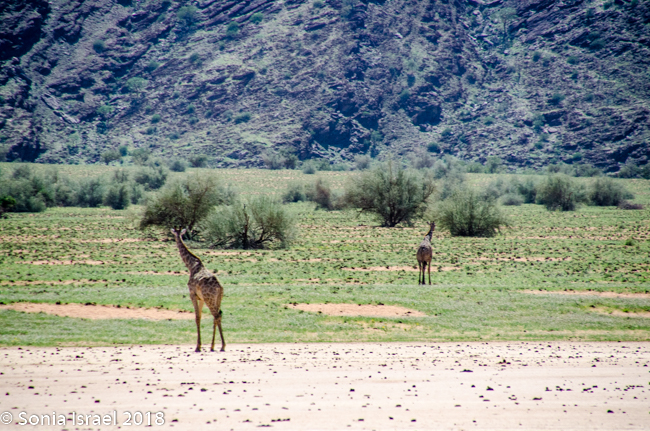

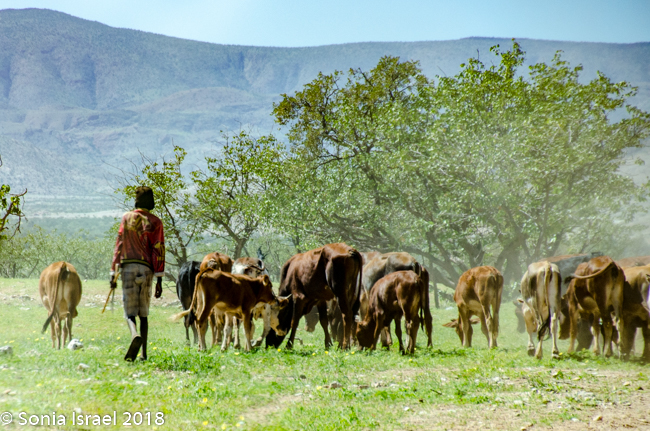
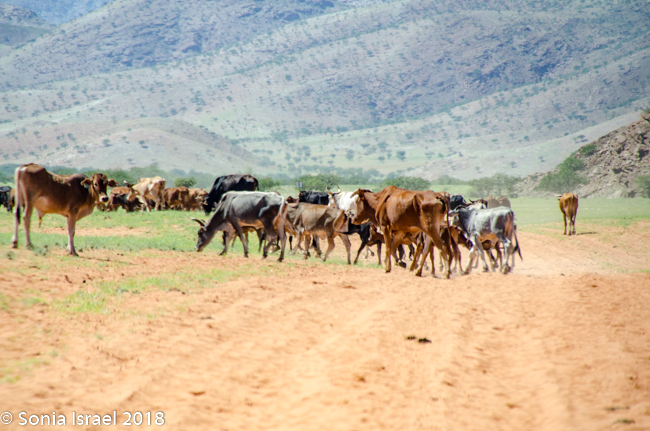
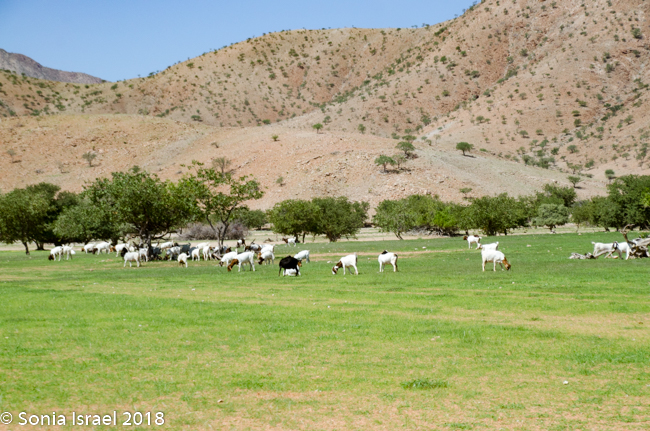
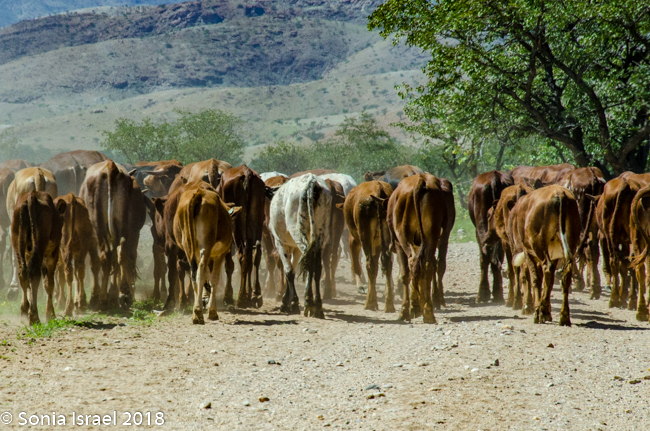
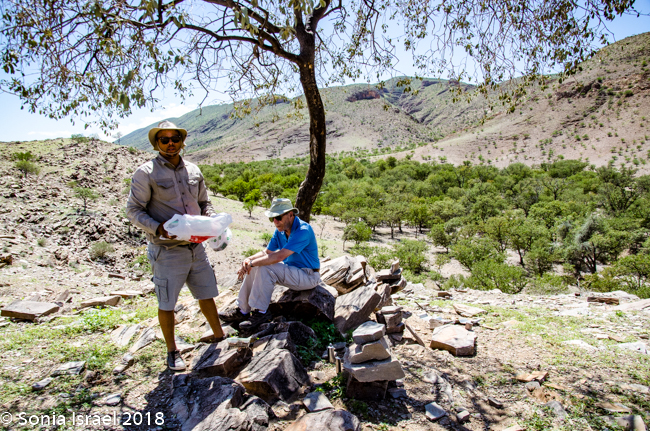

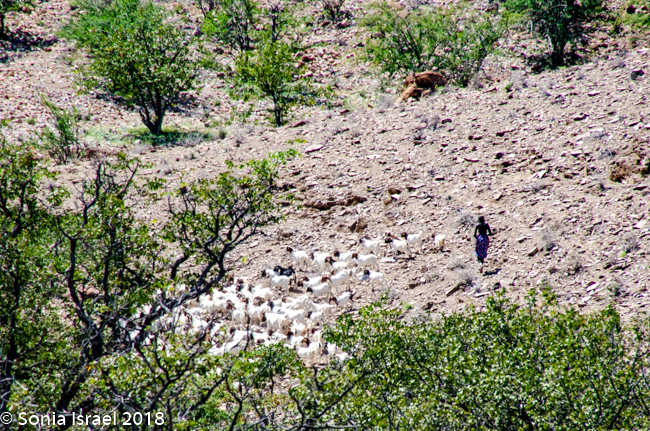
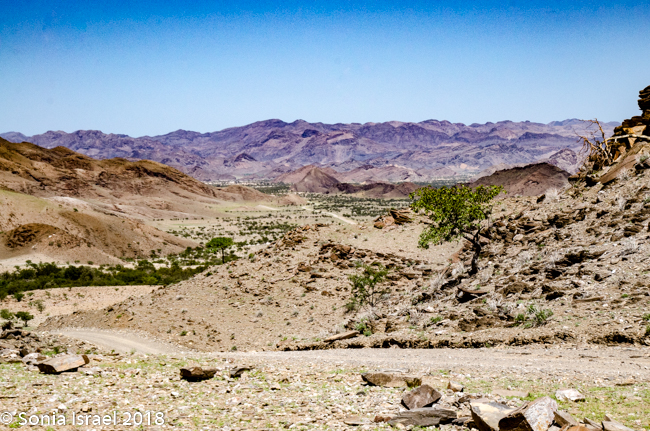
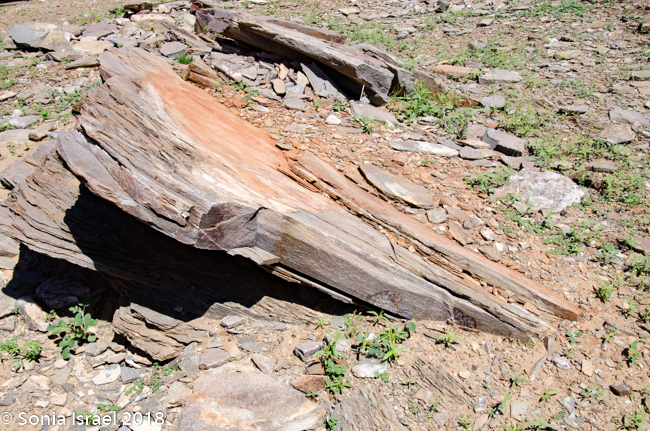



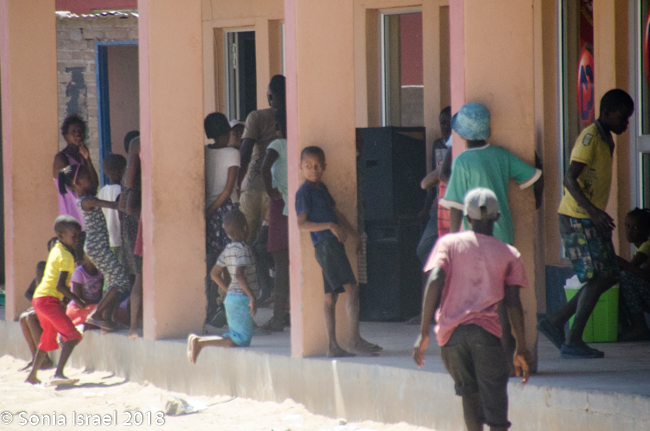
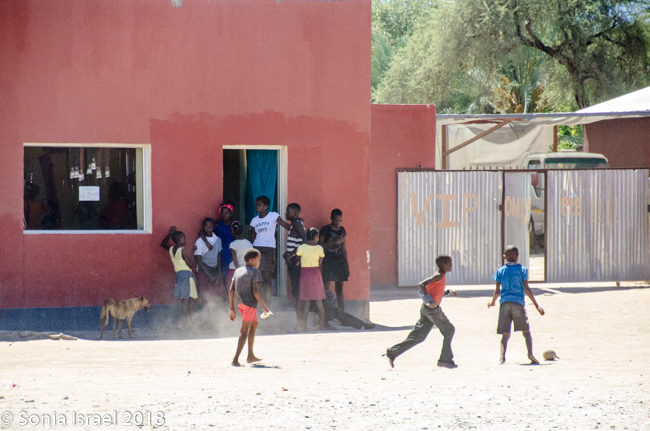

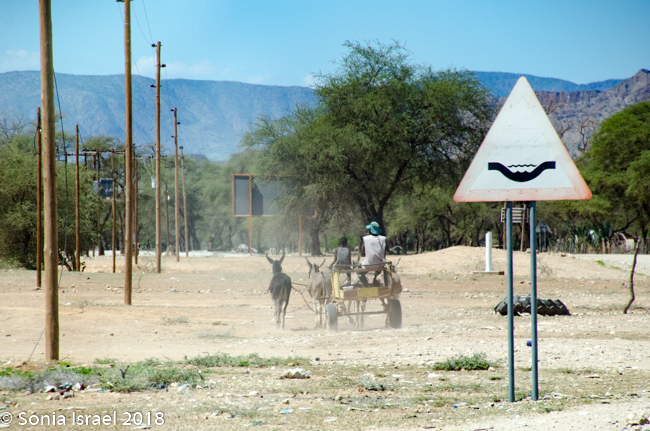

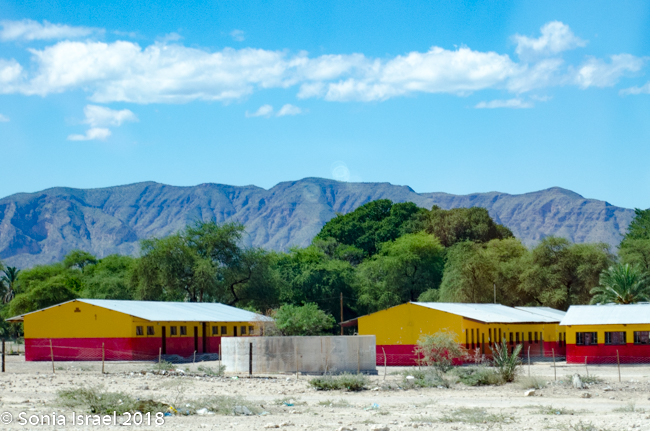
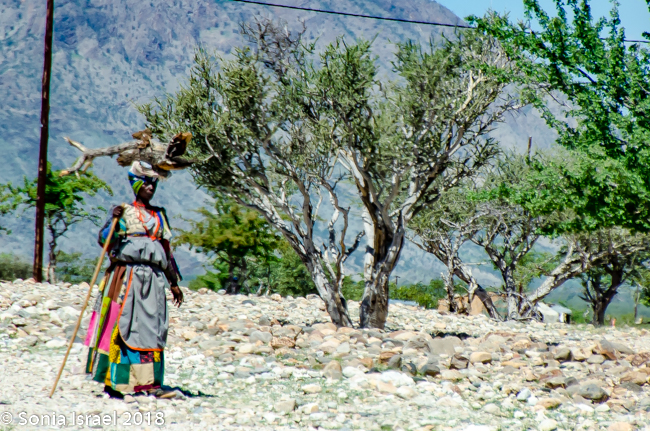
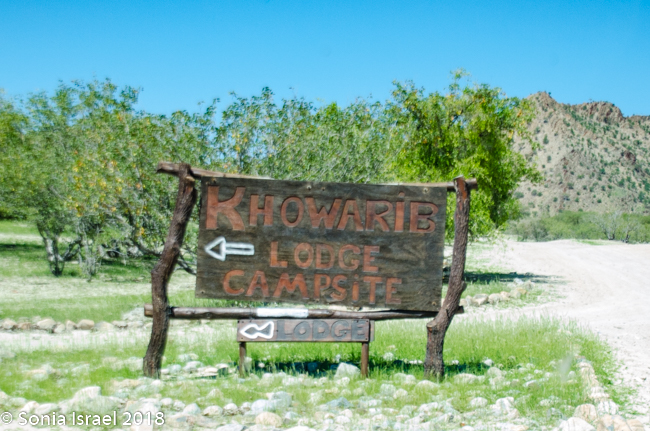
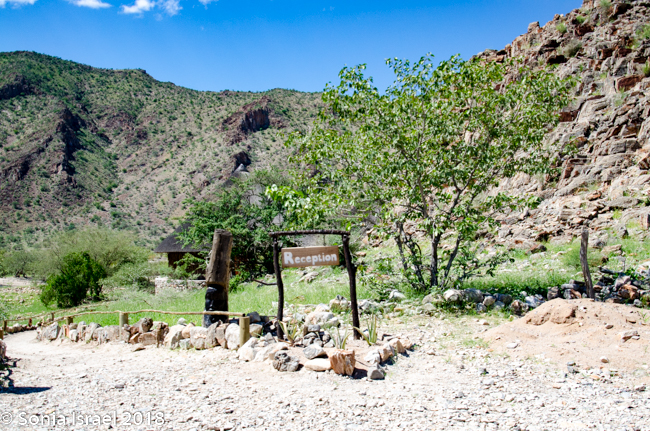
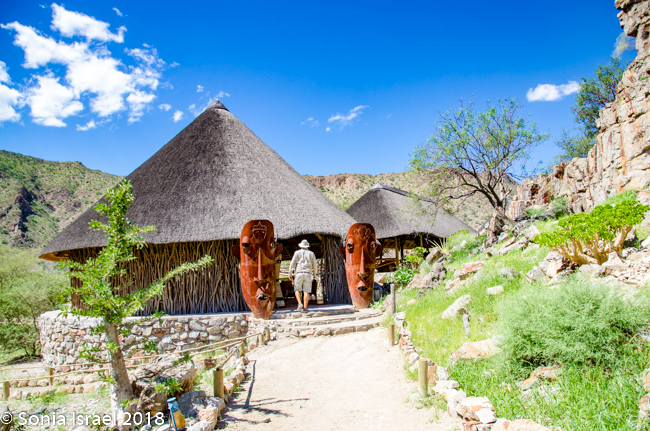

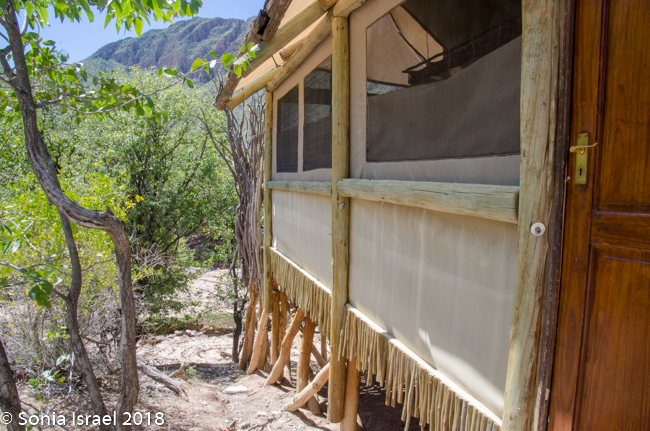
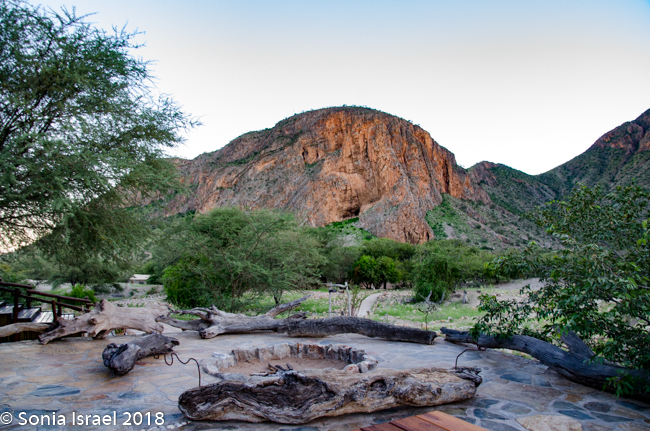
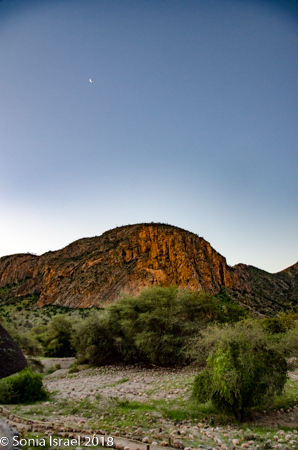
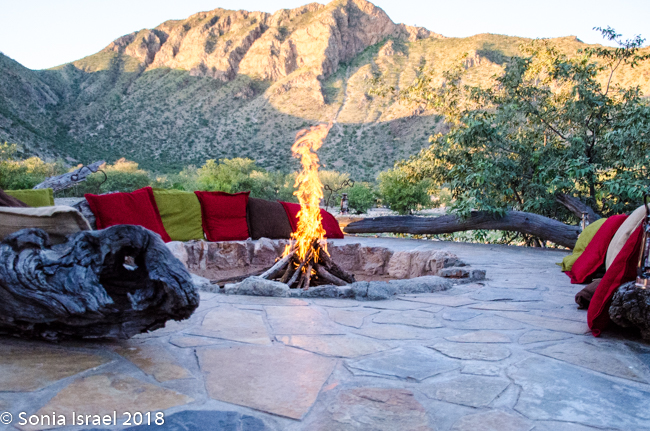
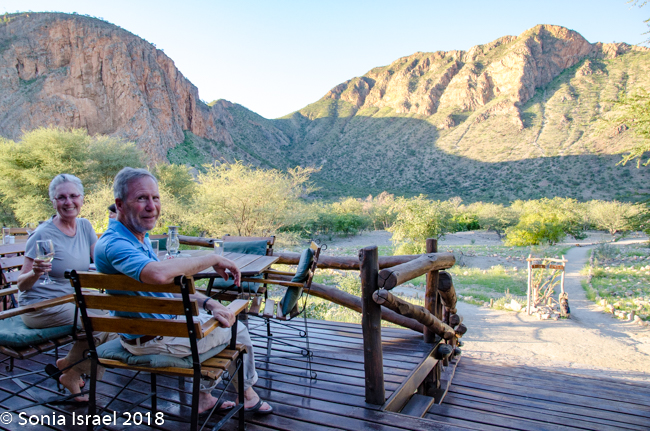
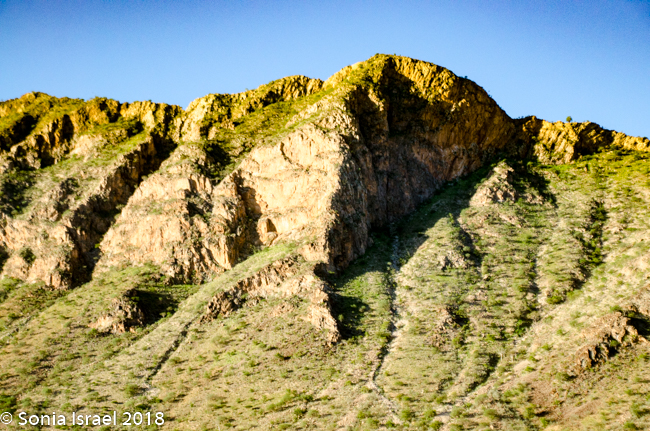
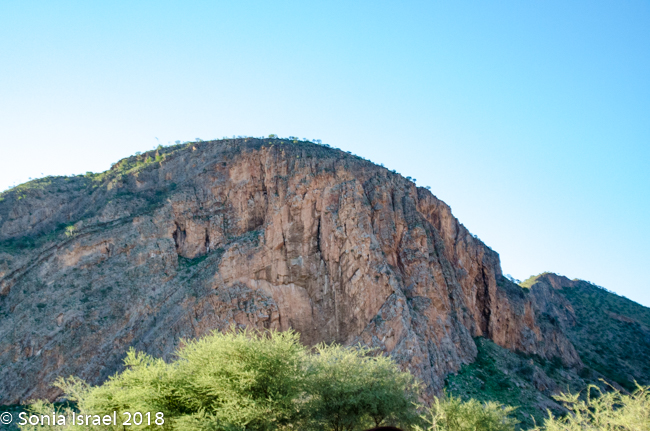
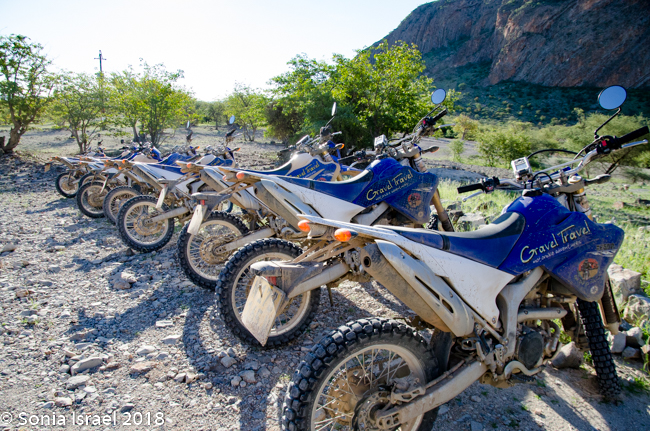
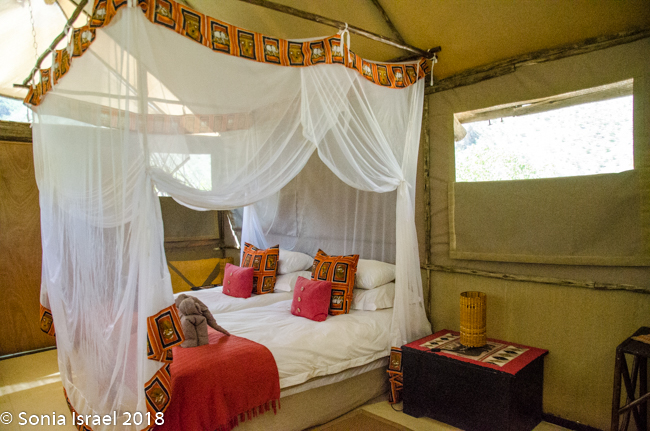
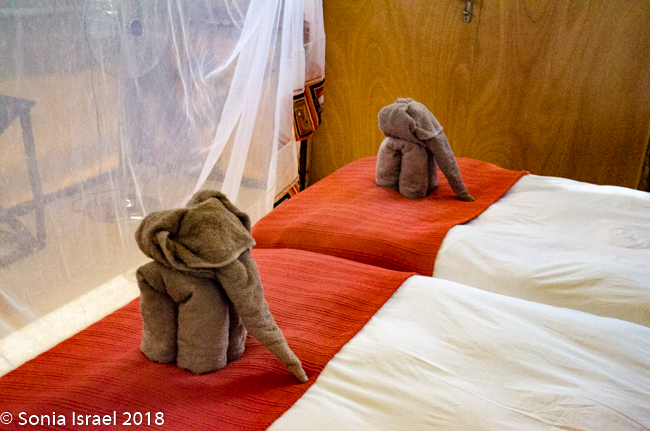





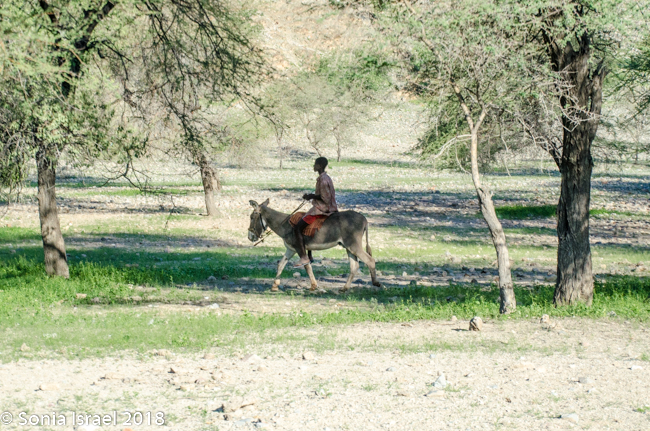
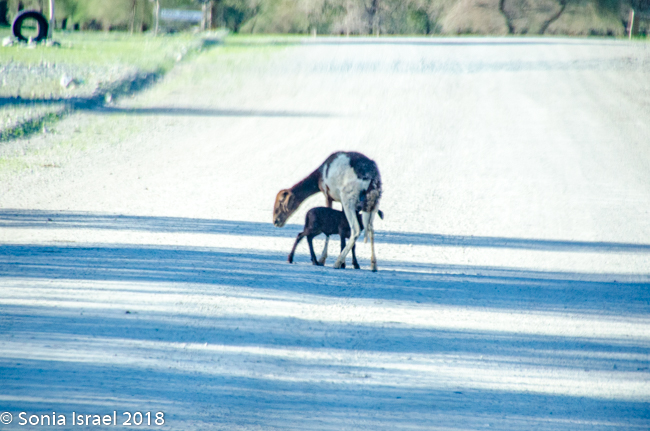

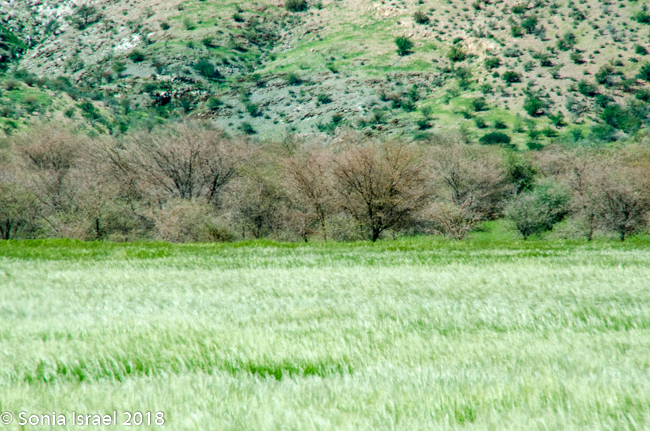
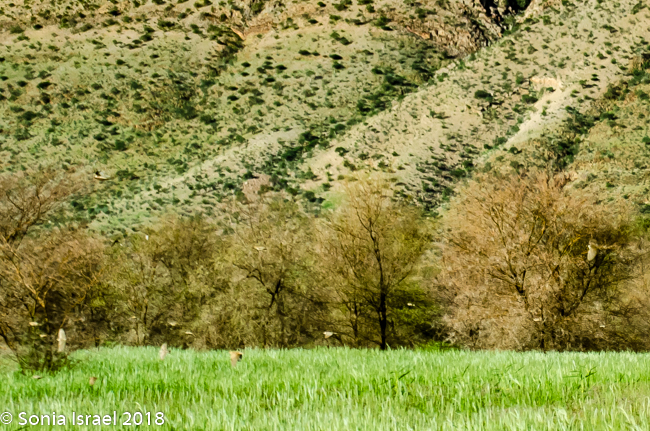
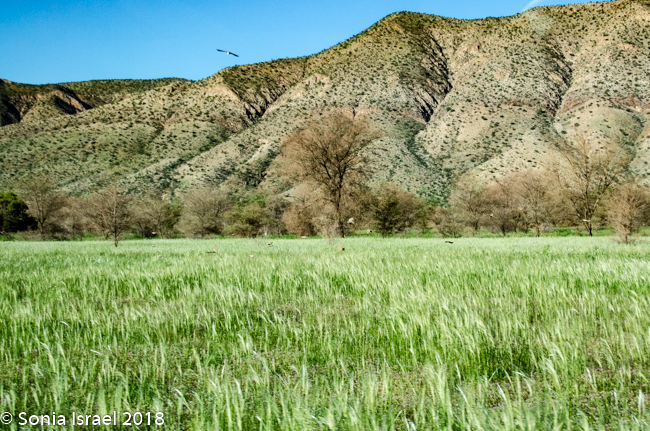
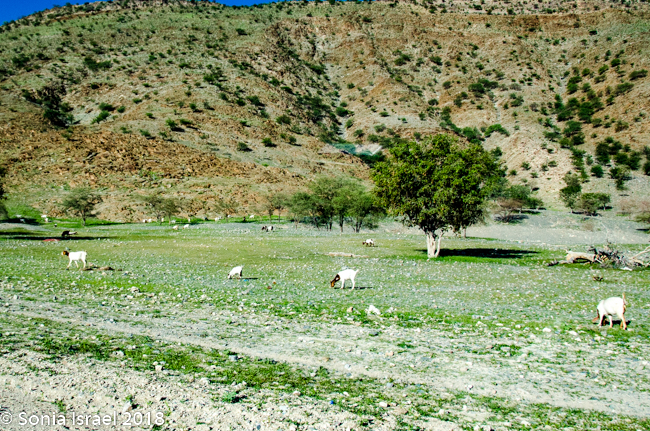
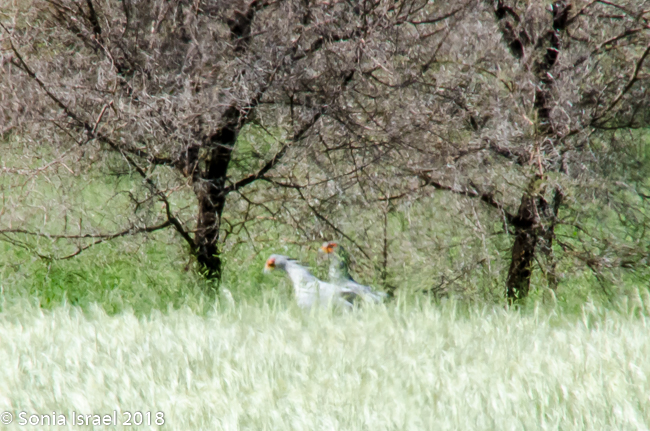

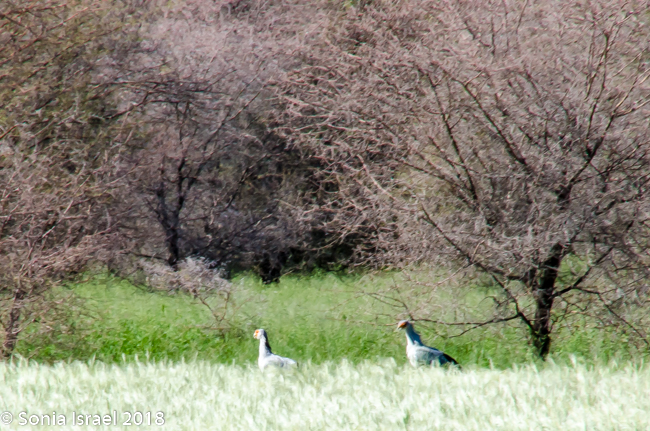
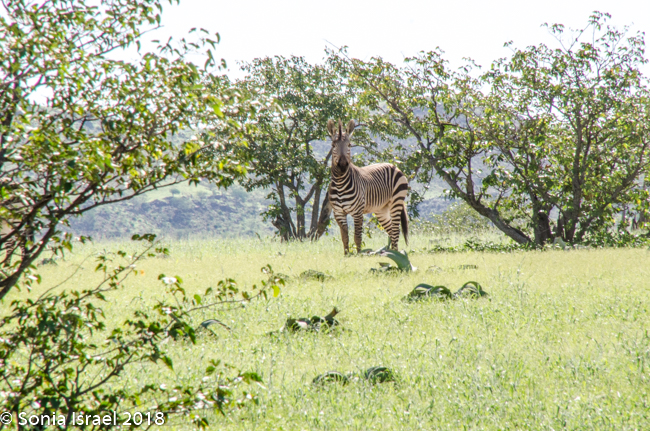

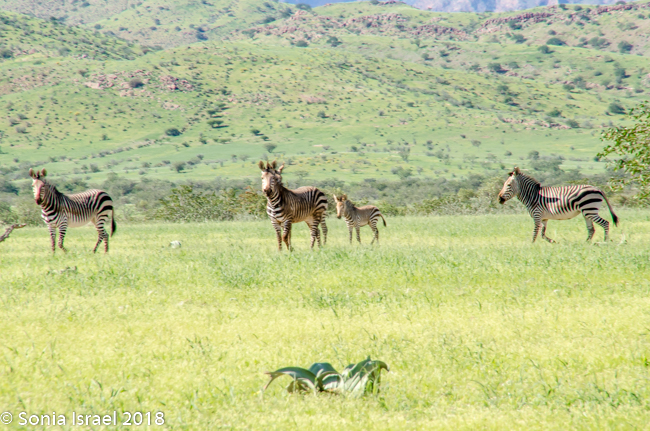
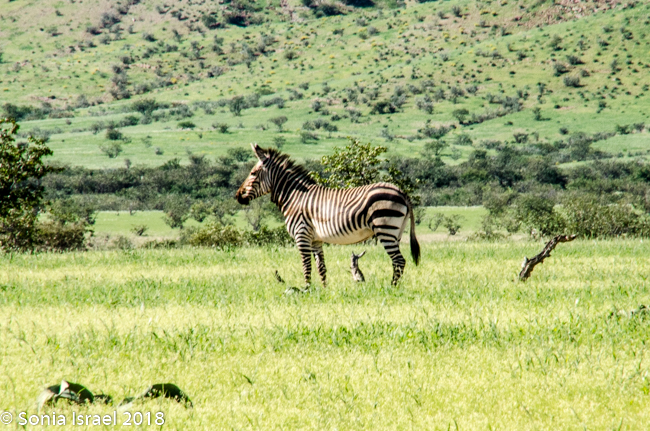
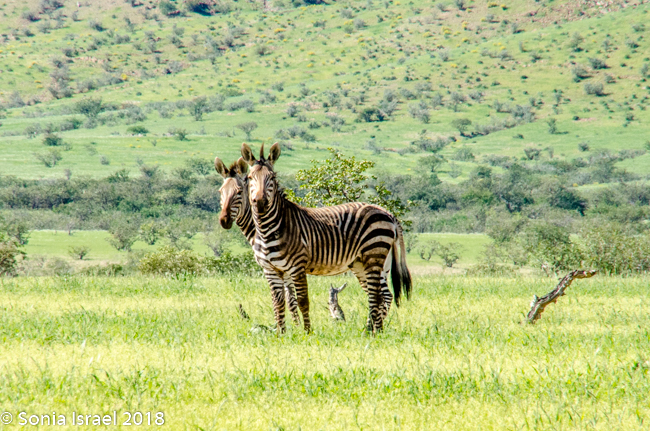

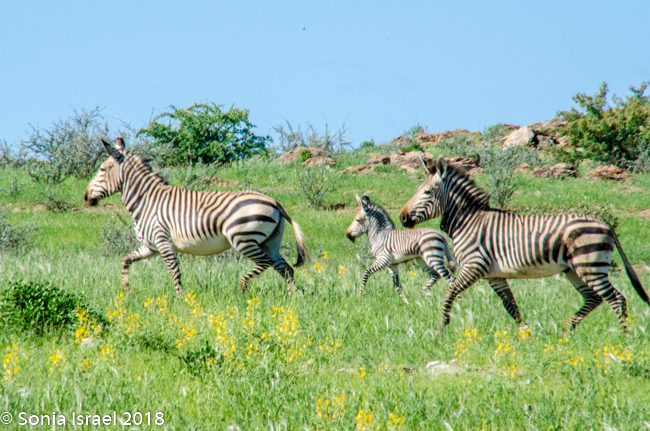
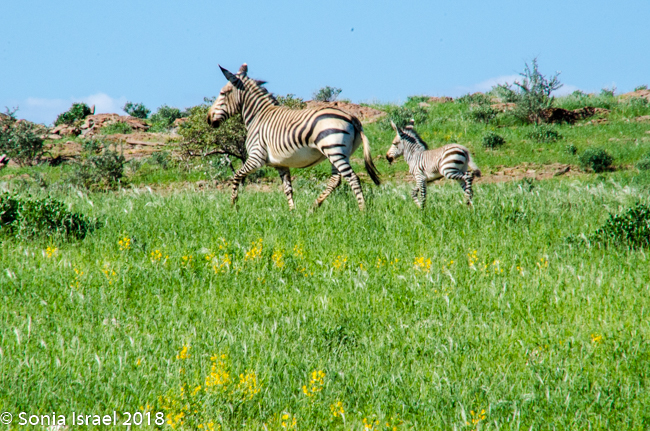

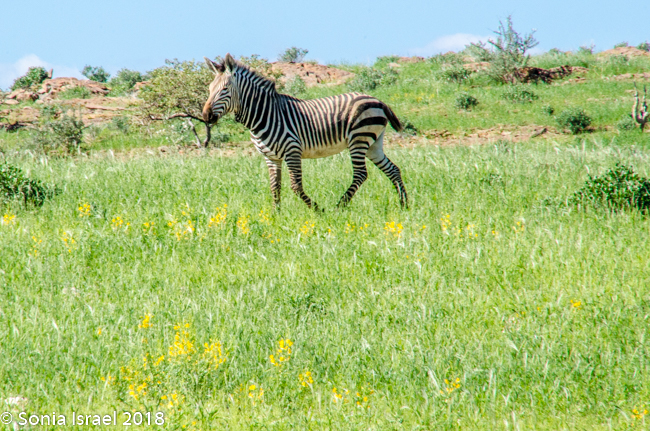

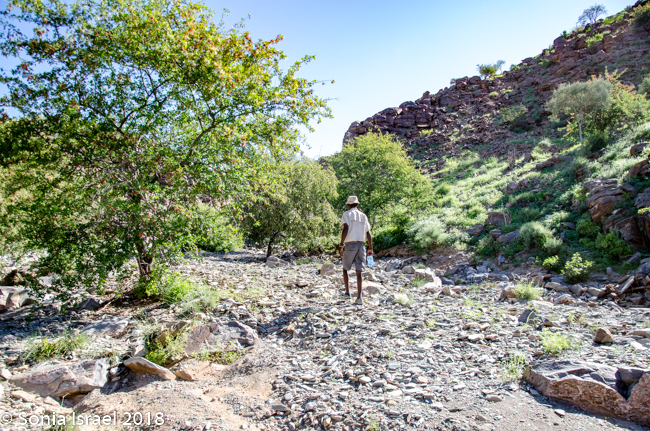
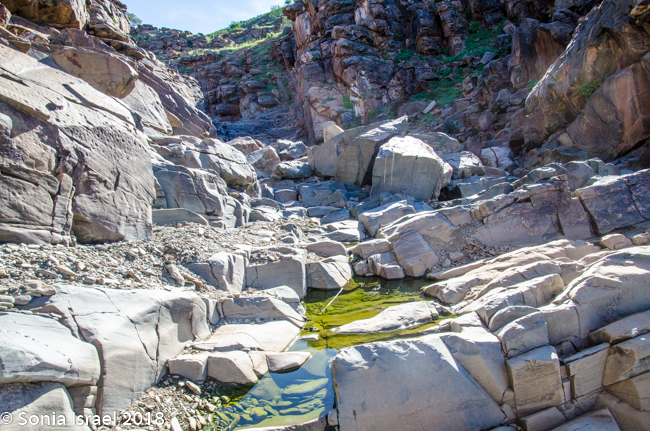
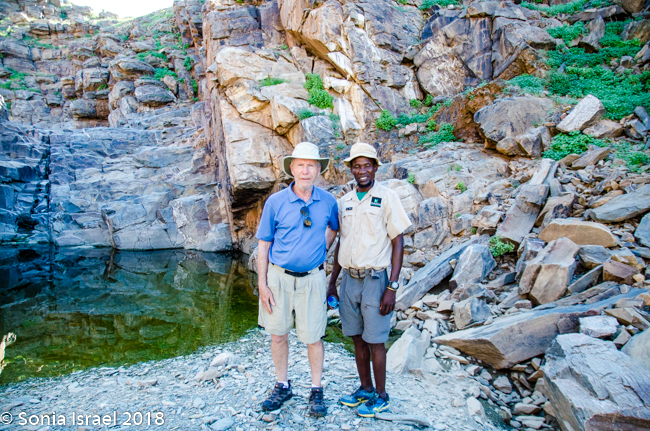

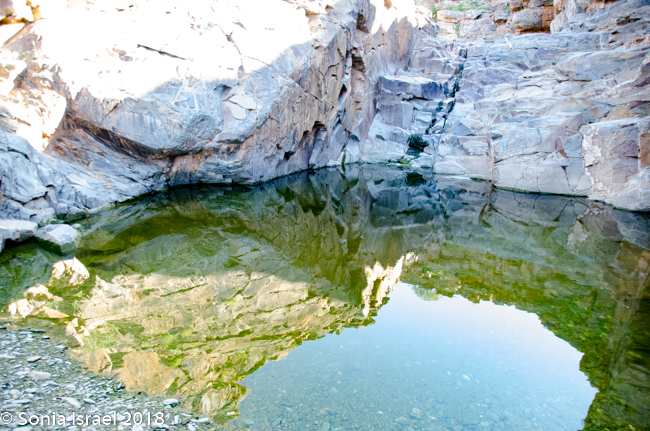

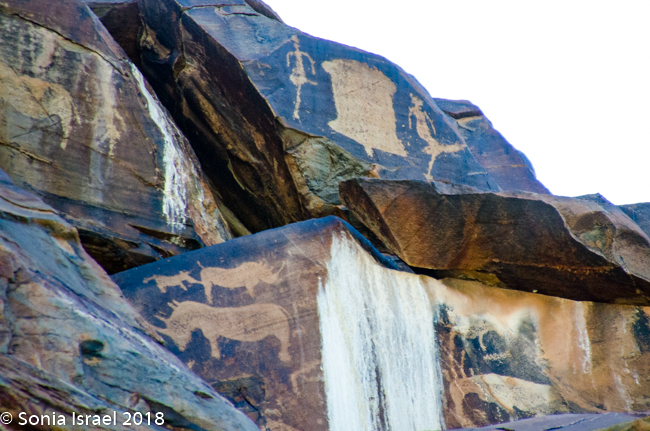
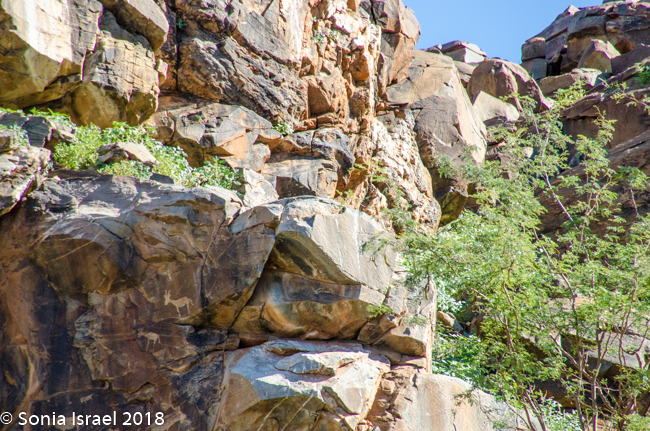
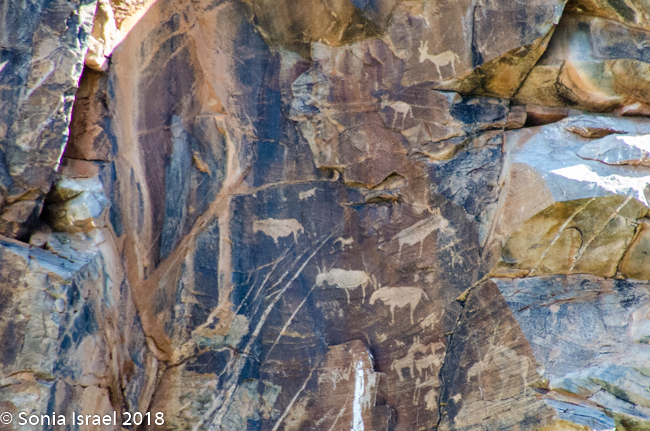
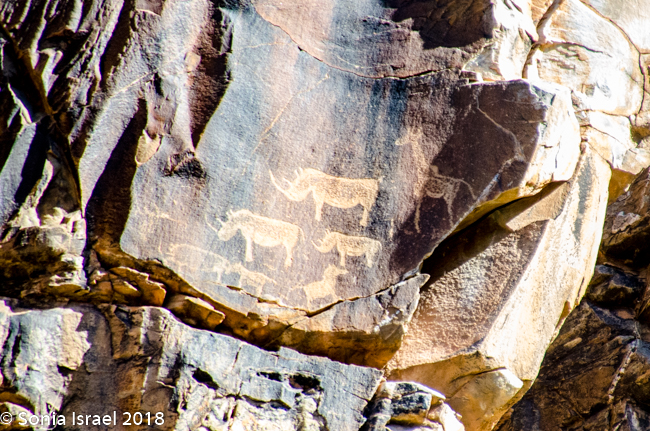
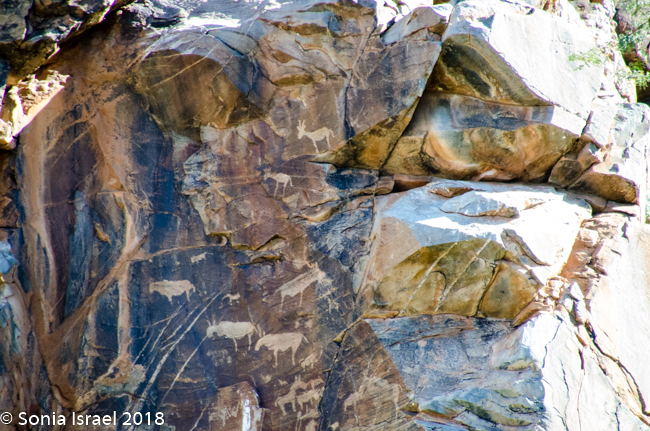
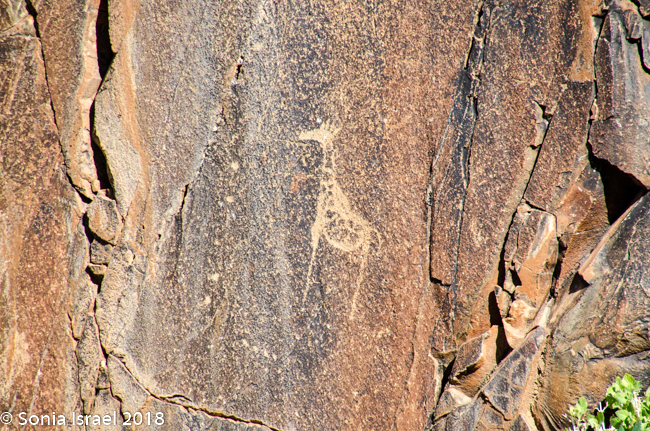
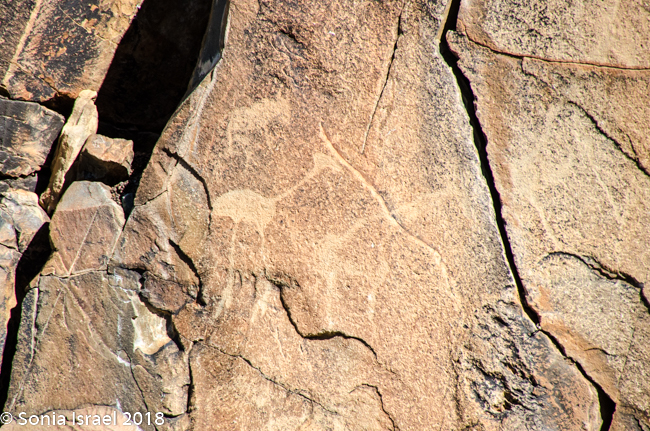
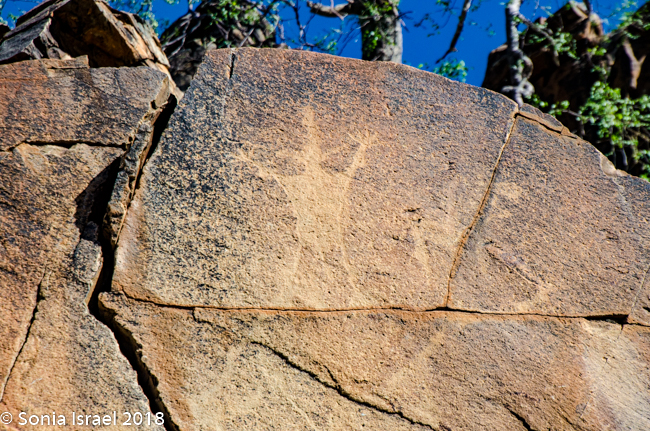
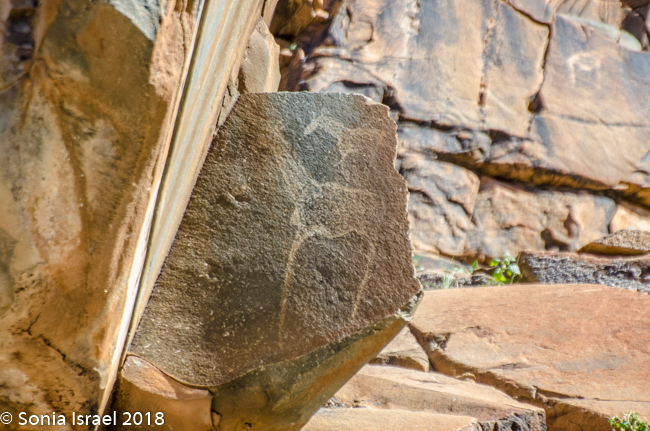
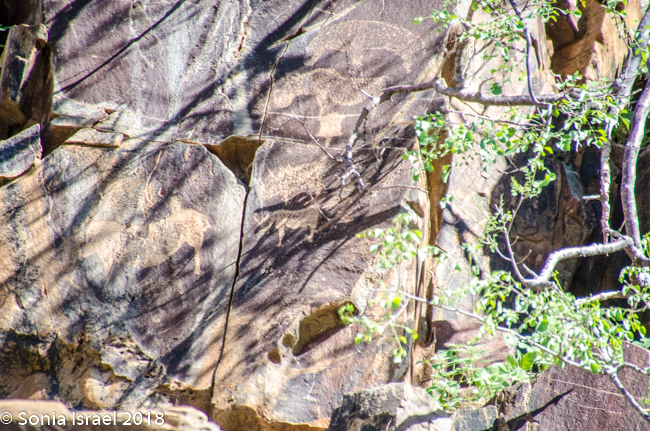
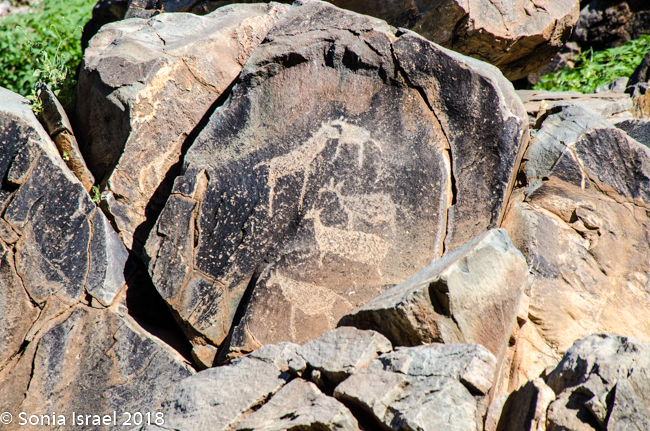
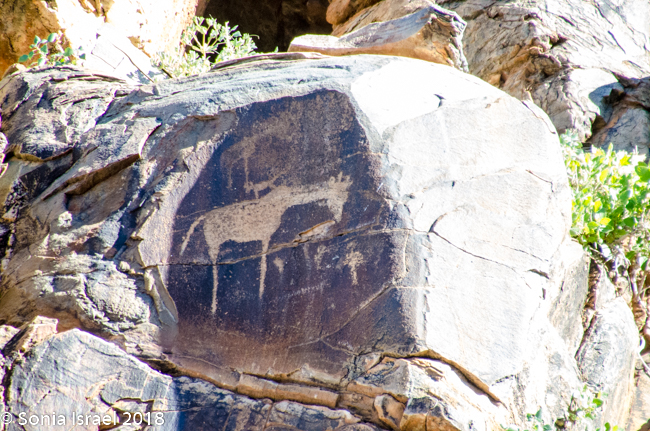
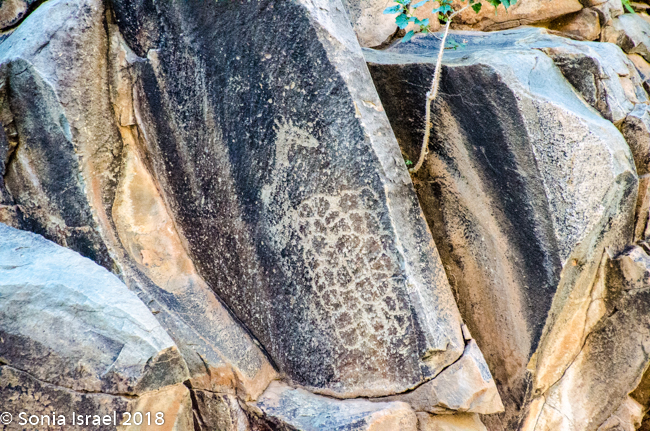
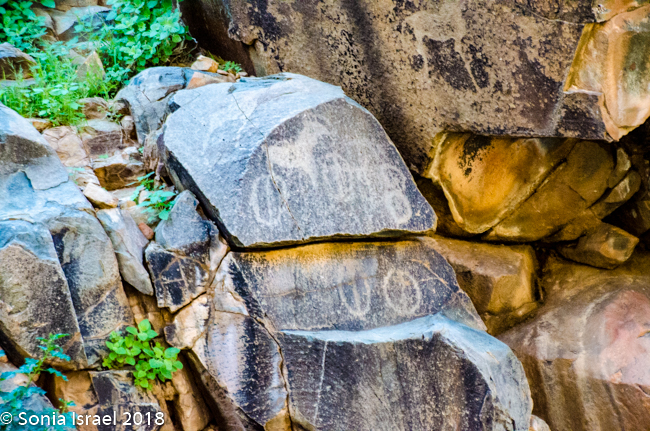
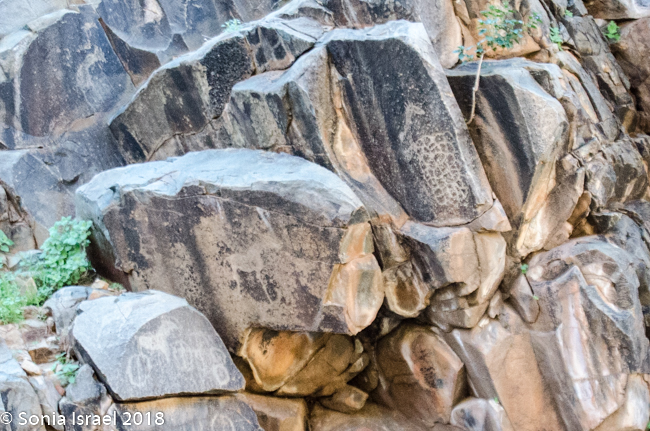

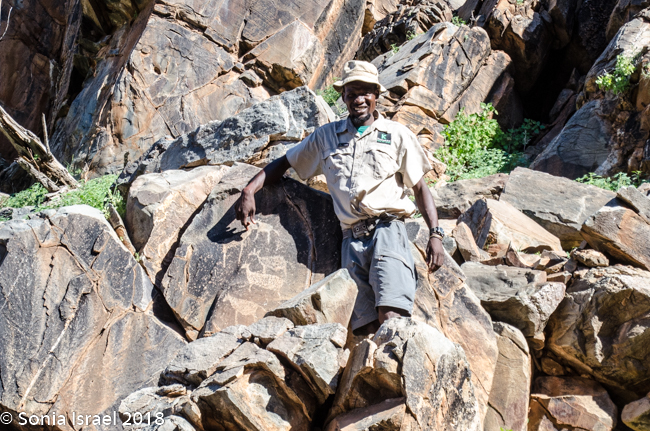


Jeff Watson
Love reading about Namibia! Looking at your kori bustards, I believe they are actually secretary birds, which are also very cool. They have red on their faces whereas kori bustards do not.